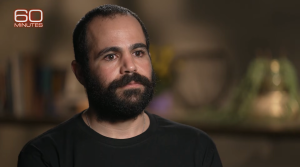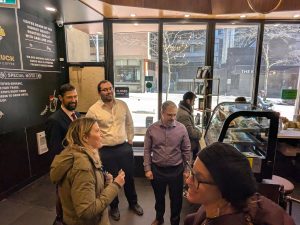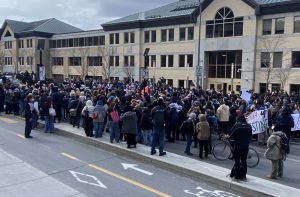Lyrical, joyous, yet often simultaneously sad, the compilation of drawings and paintings by Mark Podwal in his new book – Reimagined, 45 Years of Jewish Art (Glitterati)– speaks volumes of how the artist views the plights and predicaments of Jews through time and place.
Art never figured as a career for Podwal, who is professionally the clinical associate professor of dermatology at New York University School of Medicine in Manhattan.
“Growing up in Queens, if you did very well in school you became a doctor or a lawyer,” he explains. “While in medical school, the tumultuous events of the 1960s compelled me to create political drawings that impressed an art director at the New York Times, who published my first drawing in 1972.”
Through decades of practising dermatology, Podwal had his art published and exhibited in major museums. “Visual awareness is essential to my parallel careers. I’d like to believe that being a physician and artist has made me more attentive to the wounds of this world.”
By dedicating the book “with gratitude to Elie Wiesel” Podwal credits a relationship intrinsic to his art. “In January 1977, the French government captured Abu Daoud, a terrorist of the Munich massacre,” Podwal, now 71, explains. “When he was released within a few days, Elie Wiesel condemned the affair in an open letter to president Giscard D’Estaing, which was published in the New York Times. Unaware of the letter – which had not yet appeared – I expressed my outrage in a drawing of the Eiffel Tower dreaming of an oil well. Shortly after that drawing appeared on the editorial page of the Times, Elie sent me a note asking to meet.” That meeting cultivated a rare friendship.
Wiesel – familiar with Podwal’s drawings on Jewish issues and his Haggadah on the plight of Soviet Jewry – proposed a collaboration. Podwal suggested a book on the Prague golem. This must have been “bashert,” says Podwal. “For it was my art for Elie’s book The Golem that initiated my love affair with Prague. In 1997 in Prague, Elie spoke at the opening of my exhibition Jewish Dreams at the Jewish Museum.” Subsequently, Elie involved him on every project that required an artist.
 “When president Ronald Reagan awarded the United States Congressional Gold Medal to Wiesel, the medal was engraved with my drawing.”
“When president Ronald Reagan awarded the United States Congressional Gold Medal to Wiesel, the medal was engraved with my drawing.”
On a page opposite a stunning ink drawing titled Munich Massacre, 1972 – which depicts a bloodied athlete running through Berlin’s Brandenburg Gate – Wiesel graces Podwal’s oeuvre with an eloquent forward that gives credence to Podwal’s intuitive ability to penetrate and portray the mysticism of the Jewish world – including the humour of the golem – as well as the unbearable losses through history. Wiesel writes: “Such is the power of this artist: he captures what death has forgotten to take.”
Each of Podwal’s ink drawings and watercolours in this hefty 352-page artful tome appear as a provocative, often kabbalistic visual narrative inspired by his Jewish heritage. Quoting Kafka’s statement – “writing is a form of prayer” – Podwal says, “Drawing can also be a form of prayer.”
“My heart is with the Jewish experience,” Podwal says, recounting how his mother, born in 1921 in the Polish shtetl of Dabrowa Bialostocka, traveled with her mother and two brothers in 1929 to Brooklyn, where her father was already living, preparing to settle his family.
His mother’s brother was denied entry to the U.S. for a mistaken diagnosis of an eye infection, and ultimately died during a typhus epidemic in Treblinka, Poland.
While Podwal was most often inspired by visits to Prague – which he calls “a magical city” and, once “the Jerusalem of Europe” – he shied away from Dabrowa until he received the mayor’s invitation to participate in a conference on the history of the town’s Jews.
Jews formed 75 per cent of the town’s population in 1899, but no Jews live there now. This prompted Podwal to pen a “visual diary” of his visit in a series of 18 “Chai” works on paper that present the vanished world of a shtetl in northeast Poland.
Turning the pages, and following the lines of Podwal’s art, there’s a palpable sense that he aims to draw in the thinking viewer, to elicit understanding of hidden meanings and metaphors, perhaps spirituality. For example, Podwal projects several diverse scenarios using the menorah as metaphor. The menorah turns into the Warsaw Ghetto uprising. Inverted, the menorah turns into railroad tracks. A menorah’s flames celebrate various aspects of life. Another menorah raises the people, like a pedestal facing heaven. And yet another menorah is transported on a pole carried by two marching Nazis, representing Kristallnacht.
Beyond the publication of Reimagined, several of Mark Podwal’s impressive works are coveted by international museums and institutions. Significantly, his Terezin Portfolio – comprising 42 prints depicting the history of anti-Semitism – have been acquired by institutions including the Vatican, the University of Toronto and, notably, the Bavarian State Library whose director says, Podwal’s works “collect for eternity.”
Every year Podwal creates a new poster for the New York Metropolitan Opera. After 34 years of creating satirical political drawings for the Times Op-Ed page, Podwal says, “Political drawings no longer interest me. Succeeding generations often cannot understand their meanings.” No doubt, the art and concepts of Reimagined will endure through time.






